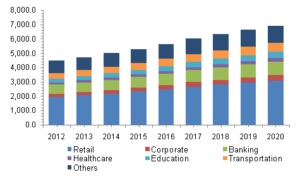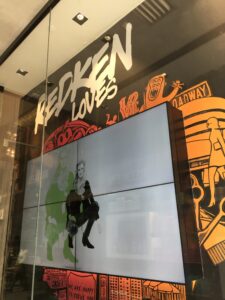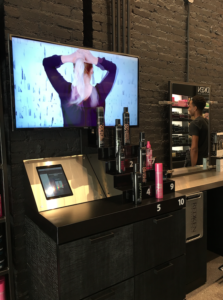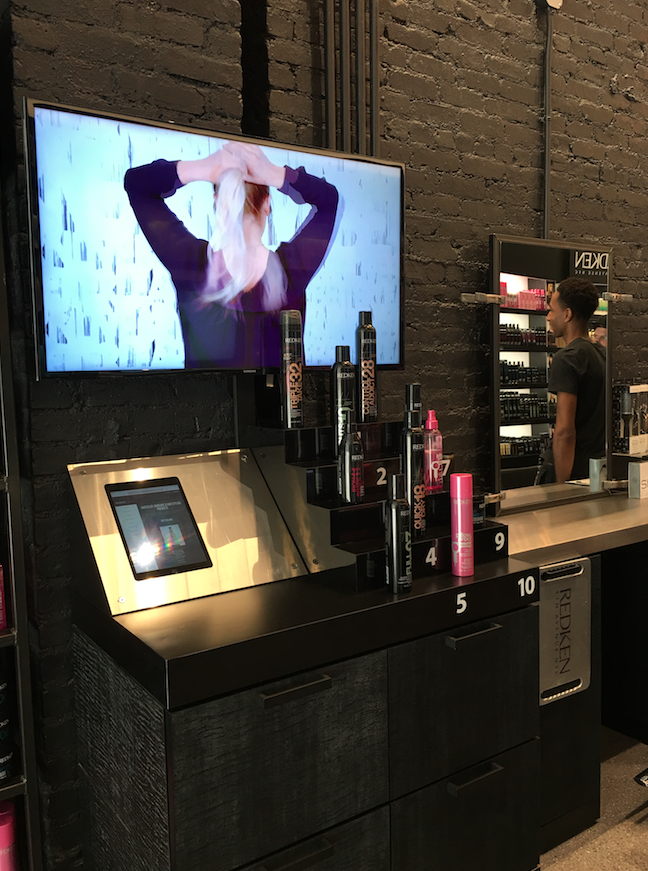In an industry where stores need to quite literally stop people in their tracks, attractive signage is key. Therefore, digital signage and retail are a match made in shopping heaven. According to Global Market Insights, the retail sector accounted for over 40% of total digital signage market share in 2015 and “is anticipated to continue leading global industry size in the coming years.”

Retail digital signage turns window shoppers into paying customers. But it’s about more than just sales. Here are five ways retail businesses use digital signage.
- Setting the mood
No…not that kind of mood.
We’re referring to retail brands using digital signage to add to the atmosphere of their stores. Content used for this purpose is usually conceptual in nature, meant to add a certain vibe to the brand or establishment. It may not even include any text.
https://www.youtube.com/watch?v=6npzfGfGKYM&list=PLSZiNlxkOXVxTg7AiAwREe_h9EsThLvWs
Think of a perfume commercial like this one for Gucci. What it depicts – a luxury apartment, an expensive gown, etc. – conveys a particular mood or concept, without directly talking about the perfume. Digital signage can achieve the same thing, but in retail stores.
- Branding
When customers walk into your store or pass it on the street, you want them to know, recognize and remember who you are – and what you represent. In order to have this effect, retailers need to display memorable elements associated with their brand, such as their name, tagline, logo, colors, font, etc. In other words, whatever represents their brand from a visual and conceptual standpoint.

Because digital signage is highly customizable and dynamic, there’s no easier or more effective way to add branding to your retail store. A single screen can display hundreds of photos or video containing a wide variety of your branding elements. Several screens placed all throughout your store will make your brand ubiquitous and hard to forget. And whenever you want to change anything up (what business doesn’t need a re-branding every now and then?), all that’s needed is a few clicks in your dashboard.
Digital signage doesn’t just convey branding, it is branding.
Digital signage doesn’t just convey branding, it is branding. It helps portray your brand as modern, tech-savvy and ahead of the curve. Customers will not only remember who you are, but what you are.
- Showcasing products and collections
Products and collections are like brands within a brand. Of course retailers want to sell all of their products, but they often need to bring attention to particular products or sets of products. This is especially true for clothing retailers, where items vary with the seasons.
Products and collections are like brands within a brand.
Digital signage, with its ability to display countless graphics and video on one or many screens, is a fantastic tool for promoting specific products or collections within your store. A clothing retailer could use one screen to showcase their children’s collection and another to showcase jeans, for instance. Placing each screen next to its corresponding product or collection will help shoppers navigate the store as well.

In addition to drawing attention to select items, digital signage allows retailers to demonstrate products and provide detailed information in ways static signage cannot. CrownTV client Redken does so in its Redken Gallerie retail store using video, showing shoppers how to use its various hair products through professional tutorials. It’s like showing a mini-infomercial within your store – minus the terrible acting.
- Promoting sales
Everybody loves a good deal, especially when it comes to retail. And deals are all about the numbers – 30% off, 2 for 1, 5 for $20, etc. In fact, numbers are known to be a powerful marketing tool, for a few reasons:
- They attract attention. Numerals are different in appearance than text, and that which is “different” stands out and draws attention.
- They’re easy and quick to read. Is it forty percent off or 40% off?
- They instill trust. Which brand would you trust more: One that says it’s offering a sale on select items, or one that says it’s offering 15% off all back-to-school clothes? Precision = confidence.
- They tell audiences exactly what to expect. Think “20% off all purchases over $100!” vs. “Sale happening today!”
Fun Fact: For some “odd” reason…odd numbers are more attention-grabbing than even numbers.
Promoting sales is particularly important for retailers, since first and foremost they need to draw customers into their store before making any sales. How many times have you entered a store primarily because you saw they’re having a sale? We all do it.

Retail stores have been using static signage to advertise sales for centuries, but digital signage allows retailers much more control and flexibility over their content. Sales are temporary and subject to change. And static signage is…static. The effort required to put up printed signage is often disproportionate to how long a sale will last – and therefore how long the signs will be up. Digital signage, on the other hand, does not require constantly putting up and taking down signs. Changing signage as one sale ends and another one begins only requires logging onto an internet-connected device.
The effort required to put up printed signage is often disproportionate to how long a sale will last – and therefore how long the signs will be up.
Advertising sales from storefront windows is one thing, but digital signage takes things to a whole new level by allowing retailers to reach customers when and where it matters, within their store. Digital signage tablet devices can be placed right at points-of-sale, like cash registers and retail shelving areas, to show customers deals and additional purposes they may not have been aware of. Static signage can achieve this too, but touchscreen digital tablets can show slideshows, offer detailed product information, ask for email addresses and offer additional help. It’s like buying that magazine or pack of gum at the grocery store checkout line, but in your retail store.
- Customer-centric content
Consumers are at the receiving end of advertising all day, but are rarely able to be part of the conversation. Fortunately another advantage of digital signage is that it can be interactive. Digital signage apps like social media walls, where audiences can post on social media and have their post show up on your store’s screen(s), allow for more customer-centric, interactive content – a novel and fun break from the advertising they’re used to experiencing.

In addition to being fun and exciting for customers who are in your store, social media walls help generate buzz and exposure for your company online. Encouraging audiences to use a certain hashtag or post relevant content doesn’t have to start online. It can start right in your establishment with digital signage, and your customers will gladly comply. It answers their question of “what’s in it for me?” – and there’s something in it for you, the retailer, too.

